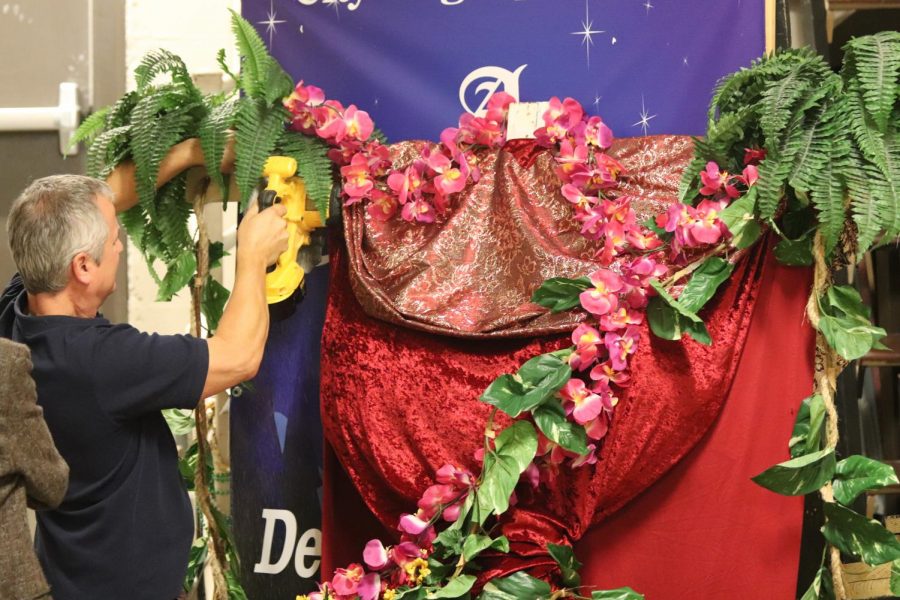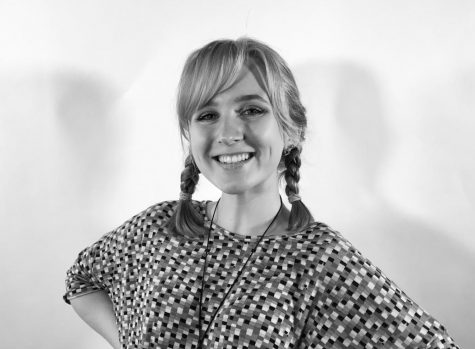Navaro Nehring features his puppets in “A Christmas Carol”
English teacher Troy Peters assembles the decorations on the Ghost of Christmas Present.
Navaro Nehring was six years old when he was given his first marionette puppet. The sophomore behind the puppets in this year’s winter play, “A Christmas Carol,” has had a fascination with the craft his whole life. When he was a child, his father would put on puppet shows for him in the basement puppet house his father made.
“I’d like to watch old reruns of TV shows like ‘The Howdy Doody Show,’ and some of the Gary Anderson ‘SuperMarionation’ series from England,” Nehring said. “And those were all done with marionette[s], and I thought it was fascinating that these people built these puppets that they used to tell these interesting stories. I was very interested in how it could act like a person, even though it was an inanimate object.”
This expertise in puppet mechanics lead Nehring to be the mastermind behind the three puppets for the ghosts of Christmas past, future, and present in “A Christmas Carol.” Director Lauren Darby first proposed the idea of using puppets last year, and the adults on the production team started gathering references and research to construct the ghosts. When Nehring demonstrated his extensive background knowledge in puppetry to Darby, he became a primary member of the puppet construction crew.
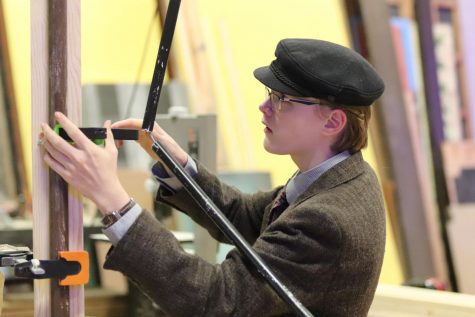
Navaro Nehring works with the structure beneath the Ghost of Christmas Future.
“He’s kind of in charge of puppetry movement,” Troy Peters said. “He’s good at coming up with the ideas for the structure underneath and making [the puppets] move. We treated him as an equal, [asking], ‘What do you think about this? What should we use? What are your ideas?’ and we just bounced ideas off each other and came up with the basic movement design for the puppets.”
The biggest challenge for Nehring, Peters, and the crew as they’ve built the puppets is balancing navigability and artistry. Although the actors who will operate the puppets are meant to be visible to the audience and don’t need to be hidden by fabric, the crew has struggled to work out how the structures, especially the eleven-foot-tall Ghost of Christmas Future, will be moved onstage from the limited space in the wings.
“It’s really a team effort because we were not always in the same room at the same time,” Peters said. “We don’t know what the challenges are going to be like, how much the fabric is going to weigh us down, and how are we going to keep that on. We didn’t know the blocking of the scene, so we’re just learning by doing it, [by] trial and error.”
Part of what made Nehring’s involvement in the team essential to their progress is his knowledge of, specifically, marionette puppets, which he describes as “an extension of your hand,” allowing one to control different parts of the puppet without directly manipulating it. Although the ghosts are technically not marionettes, being familiar with how they function has helped Nehring engineer the mechanics of the ghosts.
“Marionettes are probably the most complicated types of puppets,” Nehring said. “They’re the most indirectly connected to the puppeteer…So, there are things involved in making marionettes that apply over to just about any kind of puppets.”
The Christmas ghosts are made of wooden and metal poles, chicken wire, and newspapers, and draped in fabric and flowers for decoration. Three actors, Wolfe Fullenkamp ‘21, Maya Richards ‘21, and Kiva Weeks-Mosely ‘22, will be within the structures, operating them onstage. They also voice the characters while moving the limbs and torsos. Because the puppets are so large, it was essential the team found a way to construct puppets that could be navigated in a way that was safe as well as interesting to look at.
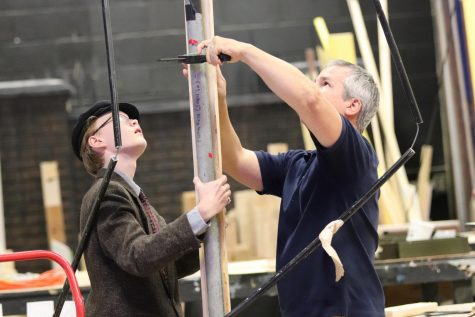
Nehring and Peters working on puppet construction.
“I think the fascinating thing about puppets is in order to do them well you need to understand all kinds of different areas of expertise,” Nehring said. “You need to know the engineering aspects and the storytelling aspects for it to come across as as effectively as possible.”
Although his interest in puppetry is currently taking the spotlight in the production of “A Christmas Carol,” Nehring boasts many other unique passions. For example, as an AP Studio Art student, he is able to explore his interest in ethnic art history.
“For a long time, I’ve been very interested in African art and Native American art,” Nehring said, “as well as various science subjects. For example, I’m very interested in early paleontology. I find it very interesting, all of the unusual and obscure species that have lived on our planet. Many of us don’t know [much about the] paleontology of dinosaurs.”
While Nehring’s many interests contribute to his life, puppetry is currently providing opportunities that have broadened his horizons, from being deeply involved in helping the winter play come to life to expanding his talents beyond backstage.
“I’ve certainly considered going into puppetry as a field outside of high school,” Nehring said. “Everyone has done an excellent job with putting everything together and making things work. It’s just been a really good time.”
Your donation will support the student journalists of Iowa City High School. For 2023, we are trying to update our video and photo studio, purchase new cameras and attend journalism conferences.
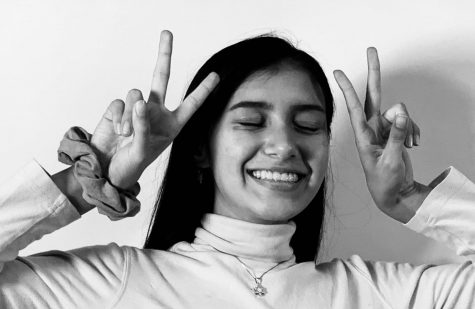
Shoshie Hemley is one of the news editors. She has a lot of opinions. She has a lot of strong feelings about a lot of things. Come talk to her to have...



























